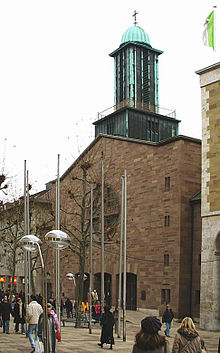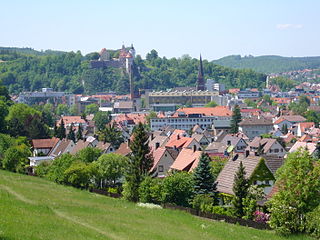
Heidenheim an der Brenz, or just Heidenheim, is a town in Baden-Württemberg in southern Germany. It is located near the border with Bavaria, approximately 17 km south of Aalen and 33 km north of Ulm. Heidenheim is the largest town and the seat of the district of Heidenheim, and ranks third behind Aalen and Schwäbisch Gmünd in size among the towns in the region of East Württemberg. Heidenheim is the economic center for all the communities in Heidenheim district and is the headquarters of the Voith industrial company. The town's population passed the 20,000 mark in 1925. Heidenheim collaborates with the town of Nattheim in administrative matters.
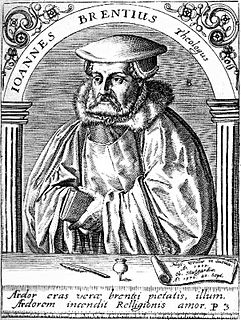
Johann (Johannes) Brenz was a German theologian and the Protestant Reformer of the Duchy of Württemberg.

Horb am Neckar is a town in the southwest of the German state of Baden-Württemberg. It is located on the Neckar river, between Offenburg to the west and Tübingen to the east. It has around 25,000 inhabitants, of whom about 6,000 live in the main town of Horb, and the remainder in 18 associated villages and districts which form part of the same municipality. If the entire municipality is counted, it is the largest town in the District of Freudenstadt.
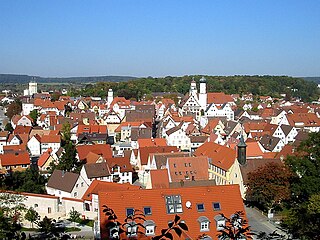
Giengen is a former Free Imperial City in eastern Baden-Württemberg near the border with Bavaria in southern Germany. The town is located in the district of Heidenheim at the eastern edge of the Swabian Alb, about 30 kilometers northeast of Ulm on the Brenz River.
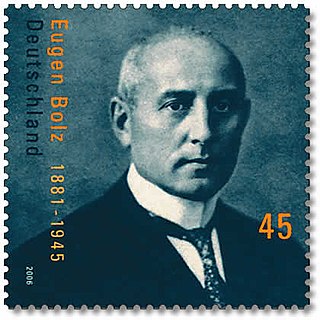
Eugen Anton Bolz was a German politician and a member of the resistance to the Nazi régime.

Engstingen is a municipality in the Tübingen administrative region (Regierungsbezirk) in Baden-Württemberg, Germany. It lies in the Swabian Jura (plateau), about 15 kilometres (9.3 mi) south of Reutlingen.

Rottenburg am Neckar (help·info) is a medium-sized town in the administrative district (Landkreis) of Tübingen in Baden-Württemberg, Germany. It lies about 50 kilometres southwest of the provincial capital Stuttgart and about 12 km (7 mi) southwest of the district town Tübingen. Rottenburg is the second-largest town of the district after Tübingen and makes up a secondary centre for the surrounding community. Since 1 May 1972, Rottenburg am Neckar has been a district town. Rottenburg agreed to an administrative collective with the municipalities of Hirrlingen, Neustetten and Starzach.

The Archdiocese of Freiburg im Breisgau is a Roman Catholic diocese in Baden-Württemberg comprising the former states of Baden and Hohenzollern. The Archdiocese of Freiburg is led by an archbishop, who also serves as the metropolitan bishop of the Upper-Rhine ecclesiastical province for the suffragan dioceses of Mainz and Rottenburg-Stuttgart. Its seat is Freiburg Minster in Freiburg im Breisgau.
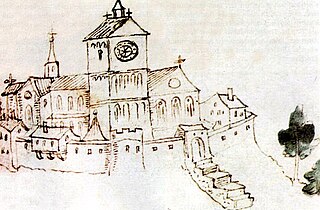
Weingarten Abbey or St. Martin's Abbey is a Benedictine monastery on the Martinsberg in Weingarten near Ravensburg in Baden-Württemberg (Germany).
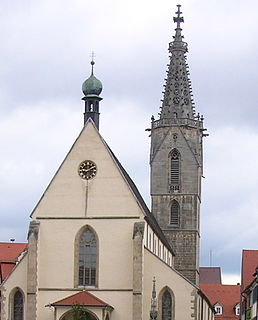
The Diocese of Rottenburg-Stuttgart is a suffragan diocese of the Latin Rite, in the ecclesiastical province of the Metropolitan Archdiocese of Freiburg of the Roman Catholic Church, in Baden-Württemberg Bundesland in southwestern Germany.
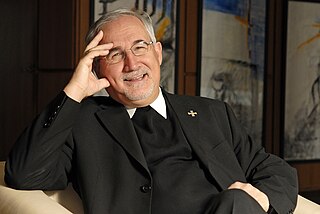
Gebhard Fürst is a German Roman Catholic bishop. He is the Bishop of Rottenburg-Stuttgart.

Ehingen (Donau) is a town in the Alb-Donau district in Baden-Württemberg, Germany, situated on the left bank of the Danube, approx. 25 kilometres southwest of Ulm and 67 km (42 mi) southeast of Stuttgart.

The Stiftskirche is a church located in Tübingen, Baden-Württemberg, Germany. It is a late gothic structure built by Peter von Koblenz in 1470. The stained glass windows were designed by Peter Hemmel of Andlau who also designed windows in Ulm, Augsburg, Nürnberg, München and Straßburg. It is the central landmark and, along with the rest of the city, the Stiftskirche was one of the first to convert to Martin Luther's Protestant church. It maintains several "Roman Catholic" features, such as patron saints.

Marchtal Abbey is a former Premonstratensian monastery in Obermarchtal in the Alb-Donau-Kreis, Baden-Württemberg, Germany. The minster church of Saints Peter and Paul, the former abbey church, located on a prominent elevation, still dominates the landscape for miles around.
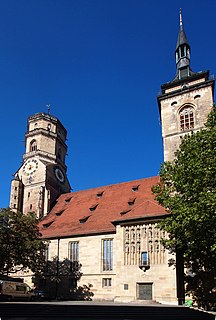
The Stiftskirche is an inner-city church in Stuttgart, the capital of Baden-Württemberg, Germany. It is the main church of the Evangelical-Lutheran Church in Württemberg as well as the parish church of the evangelical (Lutheran) inner-city church district of Stuttgart.

The Evangelical-Lutheran Church in Württemberg is a Lutheran member church of the Evangelical Church in Germany in the German former state of Württemberg, now part of the state of Baden-Württemberg.
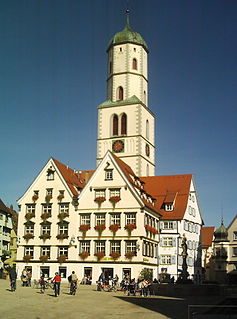
St. Martin's Church, Biberach is a church in Biberach an der Riß, in the Upper Swabia region of the German state (Land) of Baden-Württemberg. It is the oldest still active Simultaneum or shared church in Germany. Its two congregations form part of the Roman Catholic Diocese of Rottenburg-Stuttgart and the Lutheran Evangelical Regional Church in Württemberg, respectively.

Laudato si' is an oratorio composed in 2016 by Peter Reulein on a libretto by Helmut Schlegel. Subtitled Ein franziskanisches Magnificat, it includes the full Latin text of the Magnificat, expanded by writings of Clare of Assisi, Francis of Assisi and Pope Francis. The composer set it for five soloists, children's choir, Choralschola, mixed choir, symphony orchestra and organ. It was published in 2016 by the Dehm Verlag, and was premiered on 6 November 2016 at the Limburg Cathedral, conducted by the composer.
Helmut Bornefeld was a German Protestant church musician, composer, Orgelsachverständiger, and writer.
